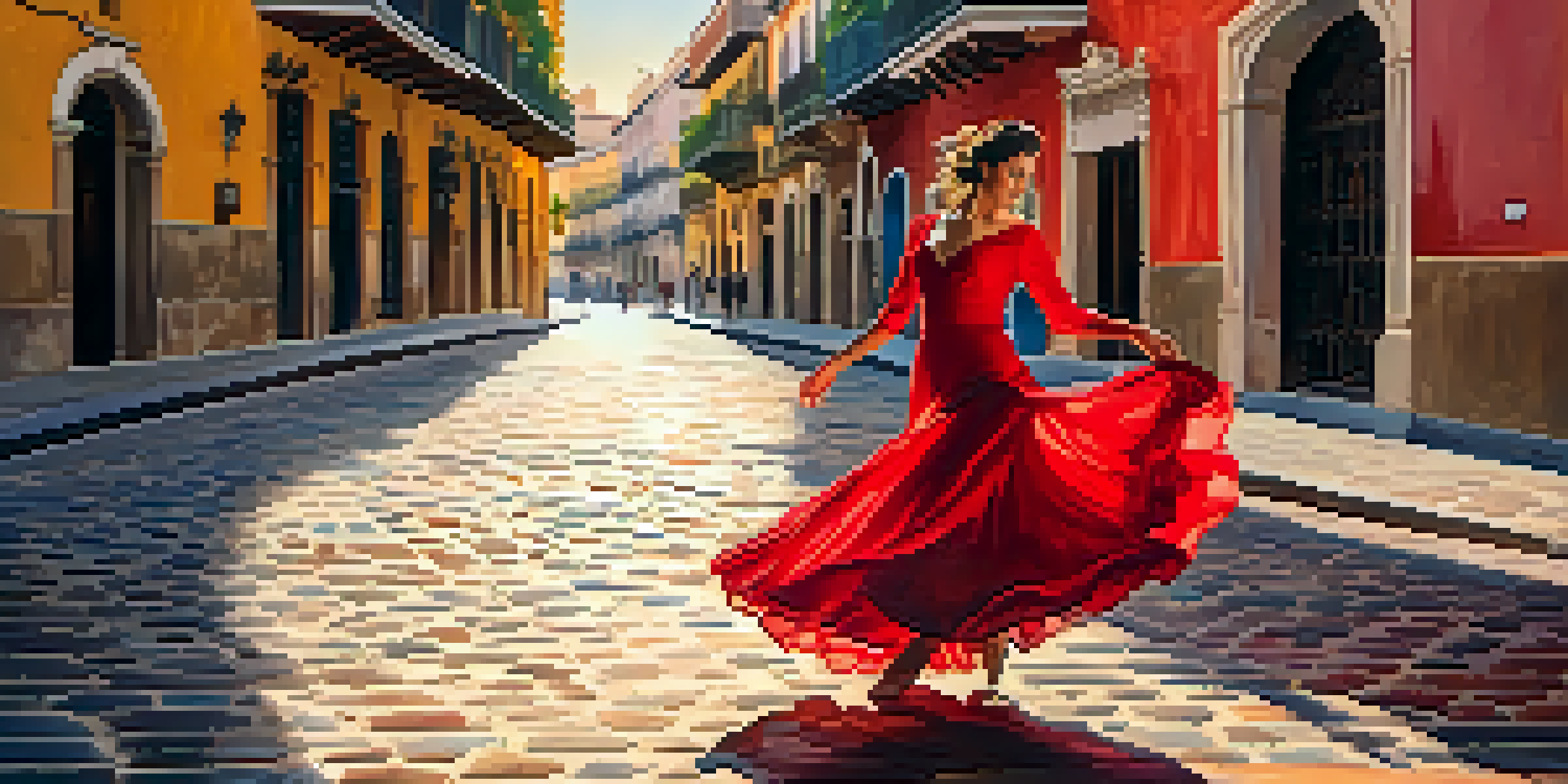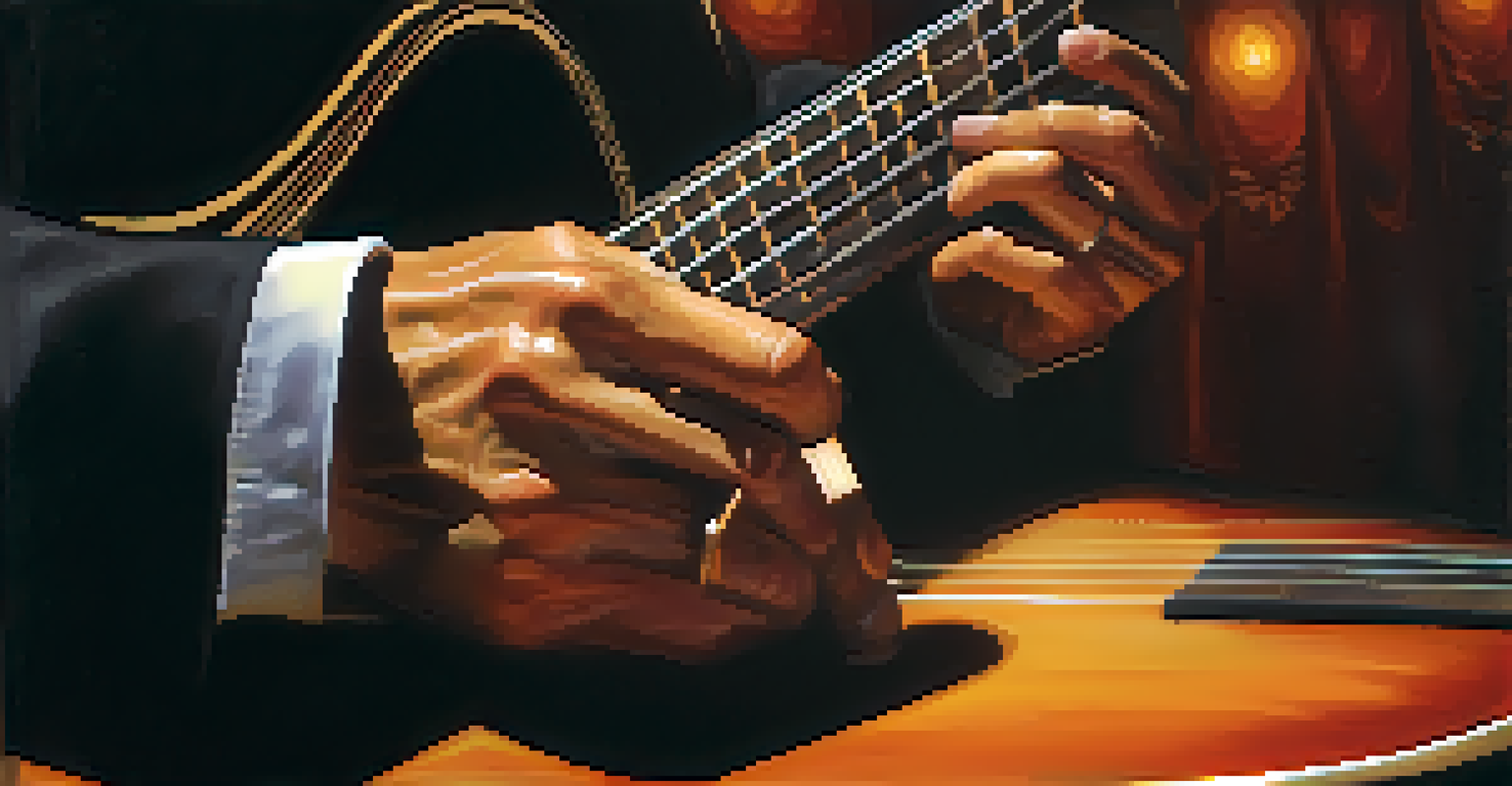The Role of Flamenco in Shaping Spain's Artistic Identity

Flamenco: A Cultural Mosaic of Spain
Flamenco is more than just a dance; it's a vibrant expression of Spain's diverse cultural heritage. Originating from the Andalusian region, it intertwines influences from Gypsy, Moorish, and Jewish traditions, creating a unique artistic tapestry. This rich fusion is what makes Flamenco not just a performance, but a storytelling medium that reflects the struggles and joys of its people.
Flamenco is the ultimate expression of the Spanish soul.
Imagine walking through the vibrant streets of Seville, where the sounds of a guitar and the clapping of hands echo in the air. These lively rhythms invite you into a world where every strum tells a story and every movement conveys deep emotion. It’s this captivating blend of music and dance that has helped Flamenco become a symbol of Spanish identity, celebrated both locally and globally.
As Flamenco continues to evolve, it embraces new influences while staying true to its roots. This adaptability ensures that it remains relevant in contemporary artistic conversations, allowing new generations to connect with their heritage. Thus, Flamenco serves not only as a reminder of Spain's past but also as a living art form that shapes its cultural narrative today.
The Emotional Depth of Flamenco Performance
At the heart of Flamenco lies a profound emotional intensity that resonates with both performers and audiences alike. The concept of 'duende,' referring to a heightened state of emotion or spirit, is essential in Flamenco performances. This feeling transforms each show into an intimate experience, where the artist connects deeply with the audience, evoking a range of emotions from joy to sorrow.

Consider the passionate strumming of a guitar or the piercing gaze of a dancer; these elements work together to create an atmosphere charged with energy and feeling. Each performance is a cathartic release, allowing both the artist and the viewers to experience the raw essence of human emotion. It’s as if time stands still, and for those moments, everyone is united in shared feelings.
Flamenco: A Cultural Tapestry
Flamenco is a vibrant expression of Spain's diverse cultural heritage, blending Gypsy, Moorish, and Jewish influences.
This emotional connection is a key reason why Flamenco resonates so strongly within Spain's artistic identity. It transcends mere entertainment and evolves into a communal experience, fostering a sense of belonging and cultural pride. As such, Flamenco not only showcases individual talent but also embodies the collective spirit of Spain.
Flamenco's Influence on Other Art Forms
Flamenco’s impact extends beyond dance and music; it has significantly influenced various art forms, including literature, visual arts, and theater. Writers and poets often draw inspiration from the themes and emotions inherent in Flamenco, weaving them into their narratives. This interplay creates a rich dialogue between different artistic mediums, showcasing the versatility of Flamenco as a source of creativity.
To dance Flamenco is to be free, to express your innermost feelings through rhythm and movement.
Visual artists, too, have found inspiration in Flamenco’s vibrant colors and dynamic movements. Paintings and sculptures often capture the essence of Flamenco dancers, embodying the rhythm and passion that characterize the art form. This cross-pollination of ideas enriches Spain's artistic landscape, making Flamenco a crucial thread in the fabric of Spanish culture.
Moreover, Flamenco has made its way into contemporary theater and film, where its dramatic elements enhance storytelling. The integration of Flamenco into these mediums not only highlights its artistic versatility but also ensures its continued relevance in modern cultural discussions. This ongoing influence reinforces Flamenco's role as a cornerstone of Spain's artistic identity.
Flamenco: A Symbol of National Identity
For many, Flamenco is synonymous with Spanish national identity. It serves as a cultural emblem that resonates worldwide, often being one of the first images that come to mind when people think of Spain. This recognition is partly due to the passionate performances that showcase the distinct musical and dance styles inherent in Flamenco, which have become iconic representations of Spanish culture.
However, Flamenco's status as a national symbol also comes with the responsibility of preserving its authenticity amid globalization. As the world becomes more interconnected, there is a growing need to maintain the unique traditions that define Flamenco. Balancing modern influences with traditional elements is crucial in ensuring that Flamenco remains a true reflection of Spain's cultural heritage.
Emotional Depth in Performance
The concept of 'duende' captures the profound emotional intensity in Flamenco, creating a unique connection between performers and audiences.
This ongoing dialogue between tradition and innovation highlights Flamenco's adaptability and resilience, ensuring its place in Spain's artistic identity for generations to come. By embracing both its history and its evolution, Flamenco continues to embody the spirit of Spain, celebrating the country's rich cultural diversity.
The Global Reach of Flamenco
Flamenco's captivating allure has transcended borders, captivating audiences around the globe. From its humble roots in Andalusia, it has evolved into a global phenomenon, influencing artists and performers worldwide. This international recognition not only showcases the beauty of Flamenco but also highlights its role in fostering cultural exchange and appreciation.
Imagine attending a Flamenco performance in Japan or Brazil, where local artists infuse their cultural elements into traditional Flamenco. This blending of styles enriches the art form, creating a global dialogue that celebrates diversity. Flamenco's ability to adapt and resonate with different cultures is a testament to its universal appeal, making it a true global treasure.
However, with this global reach comes the challenge of maintaining the essence of Flamenco. As it spreads, there is a risk of dilution or misrepresentation of its roots. It is essential for practitioners and enthusiasts to honor the tradition while embracing innovation, ensuring that Flamenco remains authentic and true to its origins in the face of a rapidly changing world.
Flamenco Festivals: Celebrating Cultural Heritage
Flamenco festivals play a vital role in preserving and promoting this cherished art form. Events like the Bienal de Flamenco in Seville gather artists from around the world, showcasing the diversity and richness of Flamenco. These festivals not only celebrate the traditional aspects of Flamenco but also encourage experimentation and innovation, allowing new voices to emerge within the genre.
Attending a Flamenco festival is an immersive experience, where audiences can witness the vibrancy of the performances firsthand. The energy is palpable, with dancers, musicians, and spectators coming together to celebrate their shared love for this art form. It's a unique opportunity to connect with the culture and history of Flamenco, deepening one's appreciation for its significance in Spanish identity.
Flamenco's Global Influence
Flamenco has transcended borders, fostering cultural exchange while adapting to various influences around the world.
Moreover, these festivals serve as a platform for education, offering workshops and classes that invite newcomers to learn about Flamenco’s rich traditions. By engaging with the art form, participants contribute to its ongoing legacy, helping to ensure that Flamenco remains a living tradition that continues to inspire future generations.
The Future of Flamenco in Spain's Artistic Landscape
As we look ahead, the future of Flamenco within Spain's artistic landscape appears vibrant and promising. With a growing interest in cultural heritage and traditional art forms, Flamenco is being embraced by younger generations eager to explore their roots. This revival is crucial for ensuring that Flamenco continues to thrive, adapting to contemporary tastes while respecting its historical significance.
New artists are emerging, bringing fresh perspectives to Flamenco, incorporating modern influences while staying true to the core elements that define the genre. This blend of tradition and innovation not only keeps Flamenco relevant but also attracts diverse audiences. The evolution of Flamenco reflects the dynamic nature of Spain itself, where history and modernity coexist harmoniously.

Ultimately, the continued celebration and promotion of Flamenco will play a key role in shaping Spain's cultural identity. By nurturing both its traditional roots and contemporary expressions, Flamenco will remain a vital part of Spain's artistic narrative, ensuring that its rich heritage is honored and shared with the world for years to come.